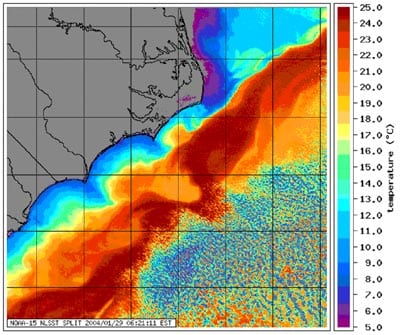Where Currents Collide and Marine Mammals Gather
July 1, 2004
Cape Hatteras, where the Gulf Stream veers off the continental slope into the deep ocean and heads toward Europe, will be the site of two intensive surveys in August 2004 and January-February 2005 to study frontal structures and the related distribution of marine mammals. During winter months, a strong surface thermal front forms which may attract bottle-nosed dolphins and other marine mammals. The summer frontal configuration is not well understood. In August, ships operating north and south of Cape Hatteras will tow instruments to obtain high-resolution data on the temperature, salinity, and current distributions in the area as they change over a two-week period. Marine mammal observers will correlate mammal sightings with oceanographic structure. In January-February 2005 the team will also coordinate their surveys with a National Marine Fisheries aerial survey of marine mammals and a larval fish survey. This work, funded by the National Science Foundation, involves Woods Hole Oceanographic Institution (WHOI), Skidaway Institute of Oceanography, Old Dominion University, Duke University, the University of North Carolina, and the National Marine Fisheries Service. For more information go to http://www.whoi.edu/science/PO/hatterasfronts/.

